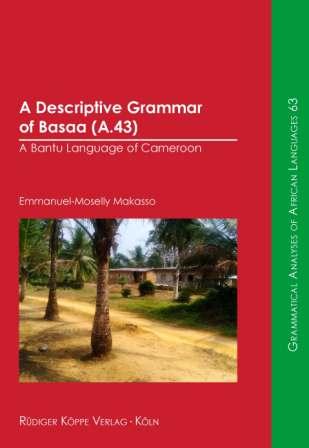
A Descriptive Grammar of Basaa (A.43)
A Bantu Language of Cameroon
Author: Emmanuel-Moselly Makasso. Series edited by: Wilhelm J.G. Möhlig †, Bernd Heine.
Series: GA Grammatical Analyses of African Languages Volume 63
2023147 pp.
1 colour map, 1 language tree model, 5 pitch contour diagrams, numerous tables and charts
Text language(s): English
Format: 170 x 240 mm
330 g
Paperback
€ 49.80
Buy 'A Descriptive Grammar of Basaa (A.43)' as a downloadable PDF document directly from our online shop »
Order 'A Descriptive Grammar of Basaa (A.43)' as print edition »
This book deals with the Basaa language, a well-known Bantu language spoken in Cameroon (according to Guthrie A.43) with about 300.000 speakers. The aim of this book is to contribute to a better knowledge of the under-documented Bantu area, but also, it is hoped to display some interesting characteristics of the Basaa language that could be used in typological and comparative studies. In his descriptive work, the author focuses on the Mbènè, a variety spoken in the Nyong and Kelle Division and in part of the Sanaga-Maritime Division.
The edition of this grammar is very timely, when presently there are experimentations going about on inserting local languages in Cameroonian school systems, as discipline and as teaching mediums. Basaa in this respect was first included in the Programme de Recherche Opérationnelle pour l’Enseignement des Langues au Cameroun (PROPELCA) and presently in Ecoles et Langues Nationales en Afrique (ELAN-Afrique).
This work benefits from concepts and notions attributed to functionalist – typological approach, with the desire to gain results accessible to both formally and functionally-oriented linguists. In certain chapters especially where phonology and prosody are treated, the analysis conducted is couched on the autosegmental phonology framework
The book ambitions to tackle many questions on scarcely documented domains in Bantu languages like prosody and its relation to morphology and syntax. Several examples are provided so that the reader can get a full picture of the language. The perspective exposed here will be useful to linguistic researchers and students, to language teachers and to the outside public who shows a lot of interest about the development of Basaa culture and language.
Under these links you will find descriptions of further Cameroonian Bantu and Grassfields Bantu languages in monographs and paper collections:
Accompanying material:
- A Descriptive Grammar of Bafut
(ISBN 978-3-89645-551-2 ) - A Descriptive Grammar of Bangwà
(ISBN 978-3-89645-563-5 ) - A Pedagogic Grammar of Babanki
(ISBN 978-3-89645-558-1 ) - Analyse contrastive des parlers Yémba du département de la Ménoua de l’Ouest-Cameroun
(ISBN 978-3-89645-046-3 ) - Grammaire descriptive du pólrì
(ISBN 978-3-89645-567-3 ) - Linguistic Salvage – Isubu and Wovea (Bantu A231)
(ISBN 978-3-89645-770-7 ) - Mòkpè (Bakweri) – English Dictionary
(ISBN 978-3-927620-33-9 ) - Mungaka (Bali) Dictionary
(ISBN 978-3-927620-30-8 ) - Structural and Typological Approaches
to Obang Grammar
(ISBN 978-3-89645-568-0 ) - Traditions, Tales and Proverbs of the Bali-Nyonga
(ISBN 978-3-927620-32-2 ) - Verbal Serialisation in Isu (West Ring)
(ISBN 978-3-89645-555-0 )
Cross-reference:
- African Languages in Global Society / Les langues africaines à l’heure de la mondialisation / Lugha za Kiafrika kwenye enzi ya utandawazi
(ISBN 978-3-89645-259-7 ) - Bantu Languages
(ISBN 978-3-89645-705-9 ) - Cameroon Professional Women in Sciences
(ISBN 978-3-89645-853-7 ) - Domains and Regions in Bantu Tense and Aspect
(ISBN 978-3-89645-772-1 ) - Engagement with Africa
(ISBN 978-3-89645-768-4 ) - Issues in Bantu Tonology
(ISBN 978-3-89645-033-3 ) - Perspektiven afrikanistischer Forschung / Perspectives de recherches africanistes
(ISBN 978-3-927620-82-7 ) - Proceedings of the 4th WOCAL World Congress of African Linguistics, New Brunswick 2003
(ISBN 978-3-89645-338-9 ) - Proceedings of the 6th WOCAL World Congress of African Linguistics, Cologne, 17-21 August 2009
(ISBN 978-3-89645-199-6 ) - Research Mate in African Linguistics – Focus on Cameroon
(ISBN 978-3-89645-041-8 ) - Sprachen und Sprachzeugnisse in Afrika
(ISBN 978-3-927620-95-7 )
| « back | Print version | [top] |
 Books
Books Audio
Audio Biographies
Biographies Series
Series Festschrifts
Festschrifts Journals
Journals